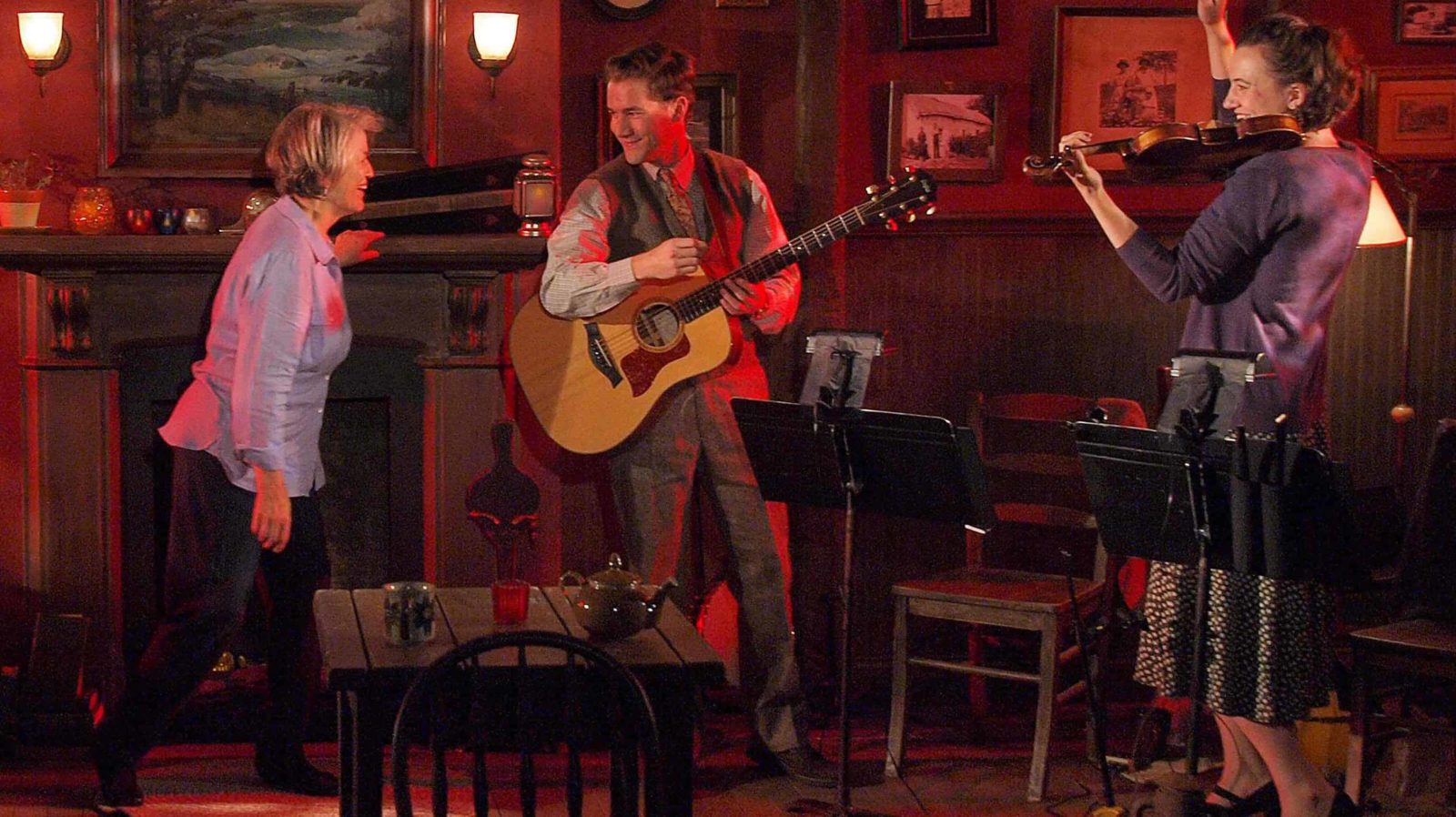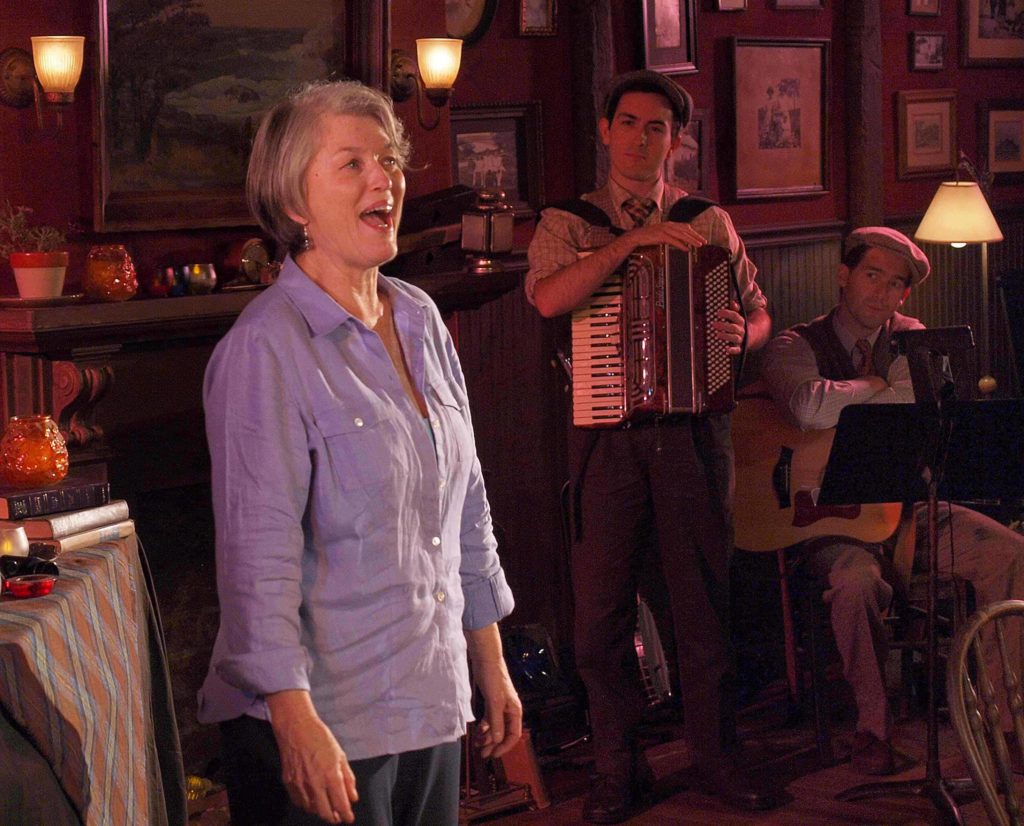The room feels like a pub — wooden beams, fireplace, wooden tables, a glass of amber liquid on the piano. Across the table, a lithe woman in a blue cotton shirt is telling you about her childhood in a Florida trailer park, her grandmother in Rochester, N.Y., and a few days in the west of Ireland. Near the river Shannon a man in a bookstore in County Clare remembered her great grandmother’s name and sent her looking for her people.
A one-person show lends itself to intimacy, and this one feels like the kind of chance conversation with a casual stranger that takes hold of you and goes on into the small hours. Cass Morgan has turned her life and her family into “The Road to Where” at Weston Playhouse.
In 1982, Morgan brought “Pump Boys and Dinettes” to Broadway as one of the original team of six musicians and actors who created a country and rock musical set in small-town North Carolina. She has a wide-ranging career including recent roles as the Bird Woman in Mary Poppins, Mama in “Memphis” and Marge in “The Bridges of Madison County.” In this new work she once again performs her own music in a script she has developed, and this time the story is her own.
Cass in the play is at a difficult time. She is coming through a divorce and caring for her aging mother, and she comes to Ireland, where her mother’s mother’s mother was born, looking for some kind of comfort or confidence or clarity.
Morgan moves fluently from one character to another, and three musicians — Eli Zoller on guitar, Pearl Rhein on fiddle and Max Grossman on piano — accompany her, sometimes stepping into a scene with her as a childhood friend or as her parents when they were young.
The Irish characters brim with warmth. Morgan sees and feels County Clare intensely, every wet sheep and cup of tea. In her eyes the country seems sometimes ideal and sometimes muddily real. In her impressions she brings out a sense of humor and sadness. Barefoot children play in the street. An old woman rows across the Shannon to the island where she lived as a girl. People share stories and music and the poverty that sent Cass’s great grandmother away. Staying in a small room in a small-town inn, Cass says her great-grandmother might not have been able to get a job sweeping the stairs here. She looks out the window at families gathering for church in their best worn clothes — spare change goes in the collection plate.
As she bikes uphill in the rain, looking for her distant family, she follows the stories of her closer family. We see her father’s long illness and her own rough, barefoot childhood. She wrestles with memories of her parents, their anger and loss. Cass in her middle years sings to her father as the young factory worker going off to World War II and her mother as the young movie usher waiting for him in their upstate New York mill town. Understanding comes to her in moments that touch near the bone.
Her songs often feel more like New York than like County Clare — singer/songwriter with a tinge of Broadway and, in her Florida childhood, a touch of country. The ring of listeners around the wall follows her along the Shannon, listening to Irish voices and waiting for Irish music.
We get hints here and there. A whistled walking tune becomes the melody for a memory of her father. A line of fiddle melody ripples like an air in a song about her grandmother taking her to Mass. A penny whistle runs like water and fades away.
For most of the show, the hints feel brief. But the Irish music does come in the end. It comes when Cass begins to feel her feet on the ground. A ballad, almost a march, propels her great-grandmother onto a ship for New York City. And the fiddle and accordion and guitar swing into a reel in the pub, the real, warm, genuine music you want to dance to. It carries the crowd along. The play has built to this energy, and now the room is alight with it.
This energy is at the heart of the show at its strongest. It’s a kind of tangible friendliness, like the unexpected conversation with a stranger that draws you in so that even when it gets painful you stay with your elbows on the table and listen.
The actors share it. The young musicians respond to Morgan eagerly, and they turn to each other as they play, trading lines of music and instruments with the casual, warm skill of a jam band, as though they have played at this pub every Friday night for years.
And at the center of the play and the room, Morgan stands with her short-cropped silver hair and her head thrown back, smiling. She moves like a dancer. She beckons like a storyteller. In the end the show rests on her, and that in itself is powerful — a show about a woman in her prime. Morgan performs a dozen characters a dozen feet away, and in this intimate setting she is most powerfully herself — inviting and open and mature.
A version of this story (updated here) ran first at the Arts Fuse. Many thanks to editor Bill Marx.


